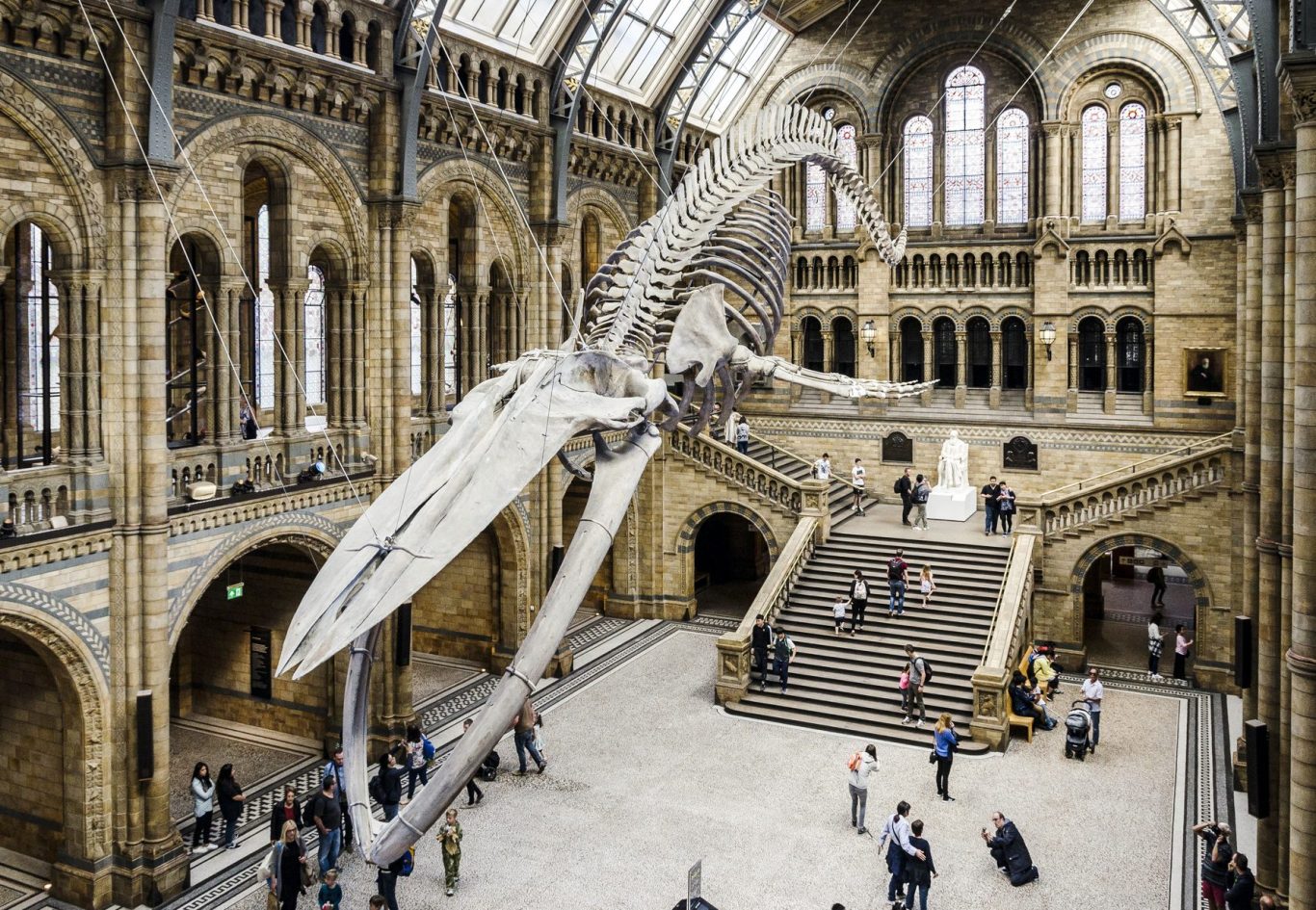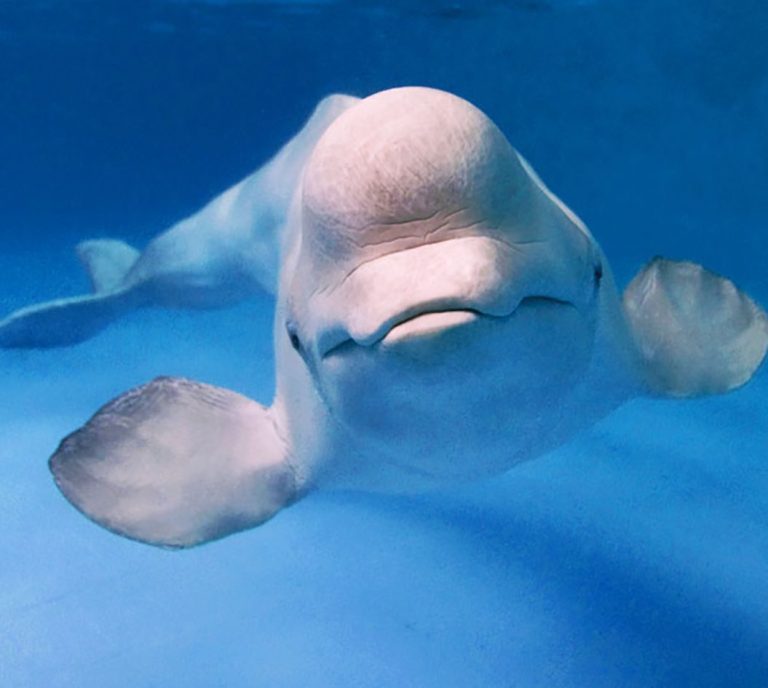11
Darwin and the whale

PeterJamesSampson/istock
A marble effigy of Charles Darwin presides over the entrance hall of the Natural History Museum in Kensington, London. Above him hangs the immense skeleton of 'Hope', a blue whale that has replaced the original dinosaur.
Evolution speculates how whales evolved from some earlier creature. It's difficult to imagine how mammals could evolve in the sea (mammals are defined as warm-blooded animals with a spine and that bare and suckle their young). It is suggested that whales evolved from some earlier land-based mammal which later moved into the sea. Darwin himself set the ball rolling by suggesting that whales descended from some kind of bear – a suggestion that he later deleted from his famous book ‘The Origin of Species’ chapter 6. Perhaps even he found it difficult to take seriously.
Should we take it seriously? What is the evidence? What sort of mechanism could account for such a fantastic change?
The only mechanism available in the current theory of evolution, are tiny changes in the DNA of the creature involved. These tiny changes (‘mutations’) are accidental changes to just one or two letters of the DNA code. These changes are known to be either neutral, too small to have any effect at all, or damaging. Occasionally it is thought they might produce some useful characteristic which changes the creature in some way. It is admitted that these changes are highly unlikely – in fact, when challenged, evolutionists have had problems identifying even just one mutation which has been beneficial. Nevertheless, the story of evolution is the story of how a succession of these highly unlikely beneficial mutations could, over a long period of time, produce a new animal altogether, with very different DNA.
What changes would be required for this small, four-legged, land-based animal (like a bear or wolf perhaps? ) to evolve into an extremely large marine animal like the blue whale? Here is a short list: (acknowledgements to Jonathan Sufarti)
Changes required:
1 Enormous lung capacity with efficient oxygen extraction
for long dives.
2 A powerful tail with large horizontal flukes to enable very
strong swimming.
3 Eyes ‘designed’ to see properly in water with its far higher
refractive index, and to withstand high pressure.
4 Ears different to those of land mammals (that pick up
airborne sound waves) with the eardrums protected from
high pressure.
5 Skin lacking hair and sweat glands but incorporating
fibrous fatty ‘blubber’.
6 Whale fins and tongues have counter-current heat-
exchangers to minimise heat loss.
7 Nostrils on top of head (‘blowholes’).
8 Specially fitting mouth and nipples so that the baby whale
can be fed underwater.
9 Baleen whales have sheets of baleen (whalebone) that
hang from the roof of the mouth and filter plankton for
food.
10 Echolocation: many cetaceans have an extremely
precise sonar system. ('Cetacean' is the name of the order
that includes whales, dolphins and porpoises).
11 Special vocal organs and ‘language’ to allow underwater
communication (eg: dolphin ‘clicks’ and whale ‘song’).
12 Weight gain! A 100-foot blue whale weighs about 400,000
lbs. Clearly the metabolism required to support such a
massive creature is utterly different to that of a supposed
small wolf-like ancestor. (Note: why is the whale so big? Is
it really an advantage in the struggle for survival to be so
big – the evidence of the dinosaurs suggests not).
Here is just one of those features described in more detail:
10. Echolocation
'One amazing feature of most echo-locating dolphins and small whales is the ‘melon’, a fatty protrusion on the forehead. This ‘melon’ is actually a sound lens – a sophisticated structure designed to focus the emitted sound waves into a beam which the dolphin can direct where it likes. This sound lens depends on the fact that different lipids (fatty compounds) bend the ultrasonic sound waves traveling through them in different ways. The different lipids have to be arranged in the right shape and sequence in order to focus the returning sound echoes. Each separate lipid is unique and different from normal blubber lipids, and is made by a complicated chemical process, requiring a number of different enzymes.
orcanation.org CC by 4.00

The beluga whale showing its distinctive 'melon' forehead.

For such an organ to have evolved, random mutations must have formed the right enzymes to make the right lipids, and other mutations must have caused the lipids to be deposited in the right place and shape. A gradual step-by-step evolution of the organ is not feasible, because until the lipids were fully formed and at least partly in the right place and shape, they would have been of no use.’
'Refuting Evolution' – Jonathan Sarfati
In other words, it is impossible to imagine a step-by-step sequence of small mutations, each of which would be beneficial, and that would eventually build the complete ‘melon’. This is true, not just of this particular organ in the whale, but just about any complex organ that you can think of.
Evidence
So much for speculation – what about evidence? A series of fossils has been put together, from Pakicetus (50 million years ago) to Aetiocetus (24– 26 million years ago). They have been arranged in the right sequence to support the evolutionary story. But we have seen it all before. The evolution of the horse (eohippus) was once regarded as a textbook example of evolution in action. But the textbooks had to change – the fossils which supported the story now lie in a basement of the American Museum of Natural history, discarded and discredited.

Pakicetus, supposed ancestor of the whale
‘The evolution of whales story is another of these fantasies of natural history. Like its predecessors, it too will soon find itself in the waste bin of science.’
‘whale fantasy from National Geographic’ – Harun Yahya 2001.
As you step inside the entrance of the Natural History Museum in London, you find yourself looking up at the most gigantic skeleton suspended from the ceiling, a 25 metres long blue whale, christened ‘Hope’ by the Museum. It inspires awe, not just because of its size, but because of its beauty and the purposeful integration of every part. Look at the incredible packing of the vertebrae in that massive spine! Here is the work of a master engineer and designer, displayed for us to recognise and wonder at. Here, ‘clearly seen’, is the evidence that the Apostle Paul talked about when he wrote:
‘…since the creation of the world God’s invisible qualities – his eternal power and divine nature – have been clearly seen, being understood from what has been made, so that men are without any excuse.’
Romans 1:20 NIV
At the far end of the Museum’s entrance hall, just below the tail of the whale, sits a marble statue of Charles Darwin, seated and presiding over the hall like some benevolent deity. This is the man who suggested this mighty creature over his head evolved from a bear, and it exhibits no vestige of design or purpose. So much of our world is still in thrall to his godless vision.
But we have a choice. The whale and every creature of this teeming planet witness to God’s mighty creative power and His plan to one day to perfect the earth, to fill it with His knowledge and His glory.
We do not use cookies on this website. We do not collect any of your personal details, and our list of subscribers is not shared with any third party.
Intelligence and purpose in the natural world
We need your consent to load the translations
We use a third-party service to translate the website content that may collect data about your activity. Please review the details in the privacy policy and accept the service to view the translations.
